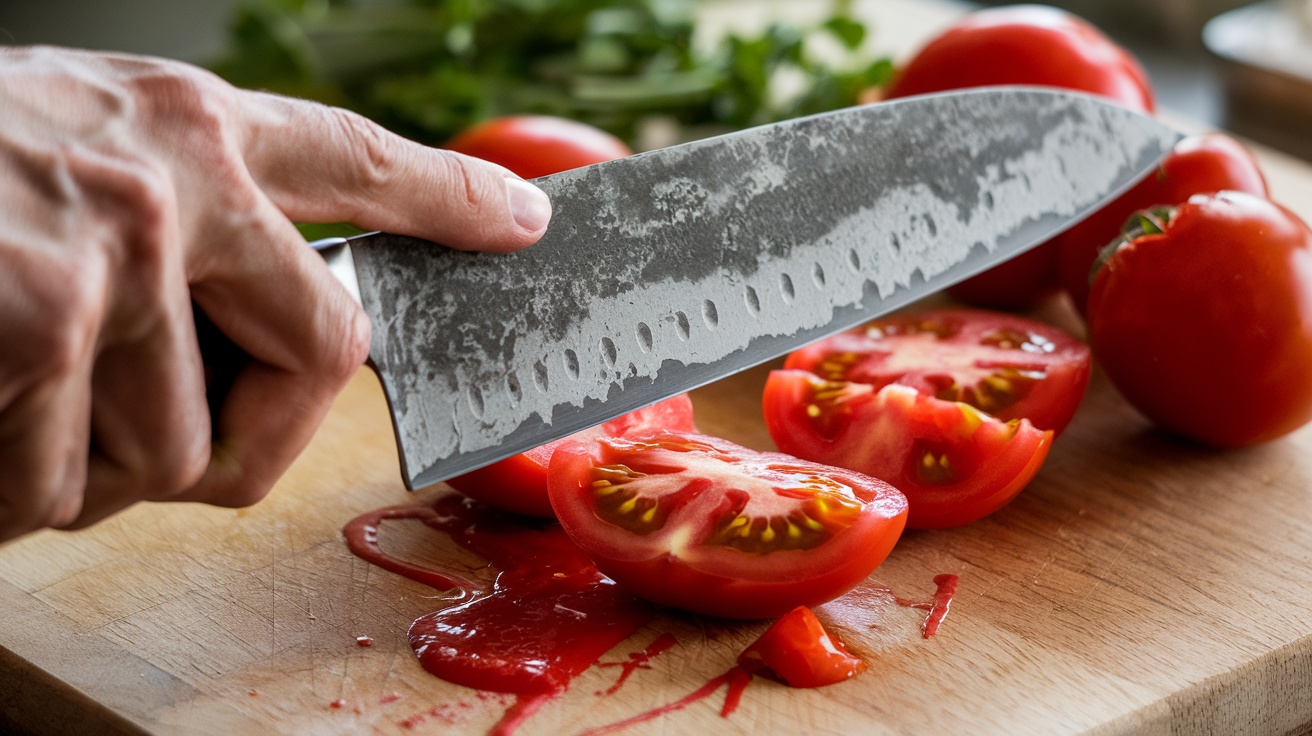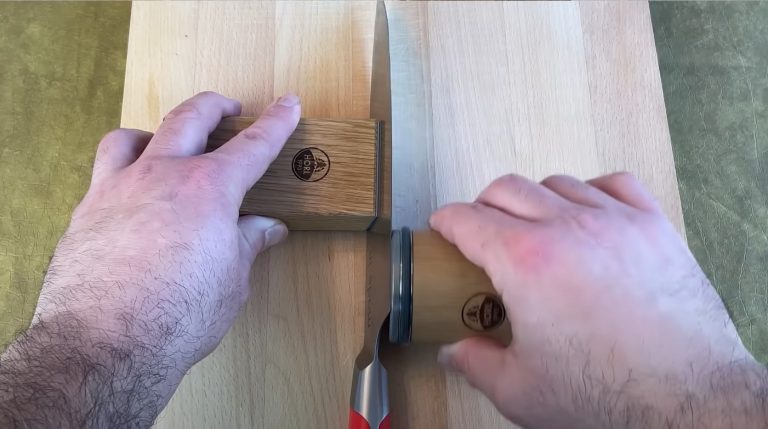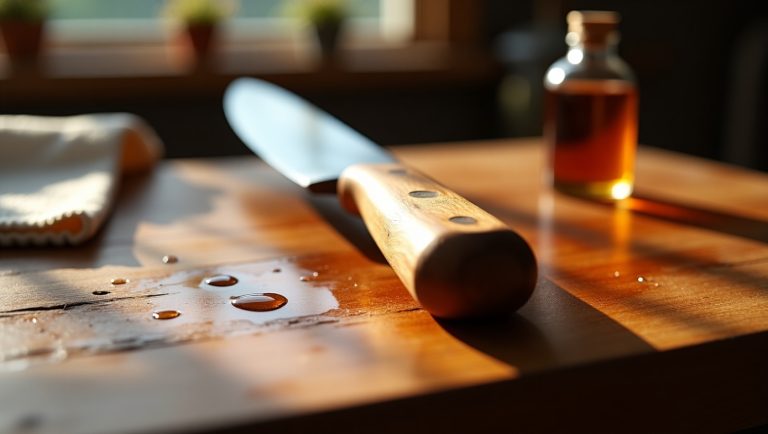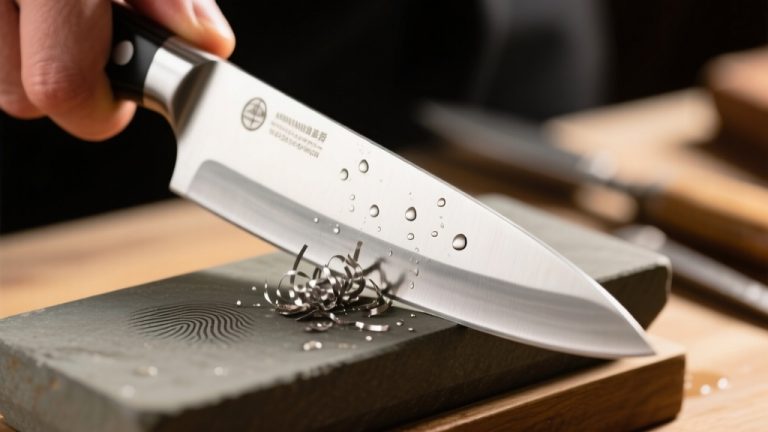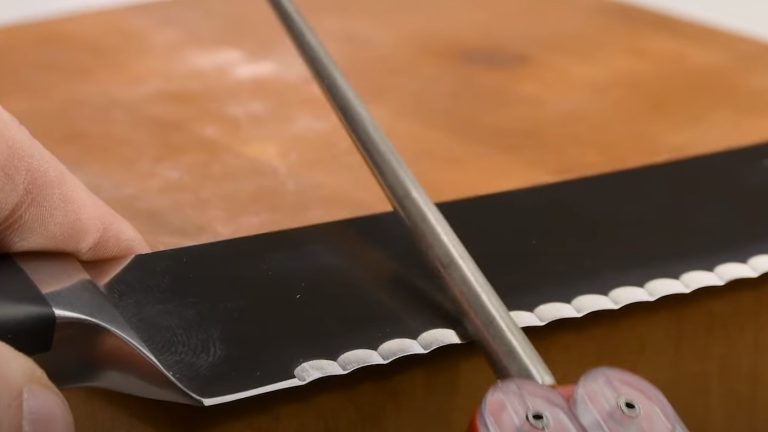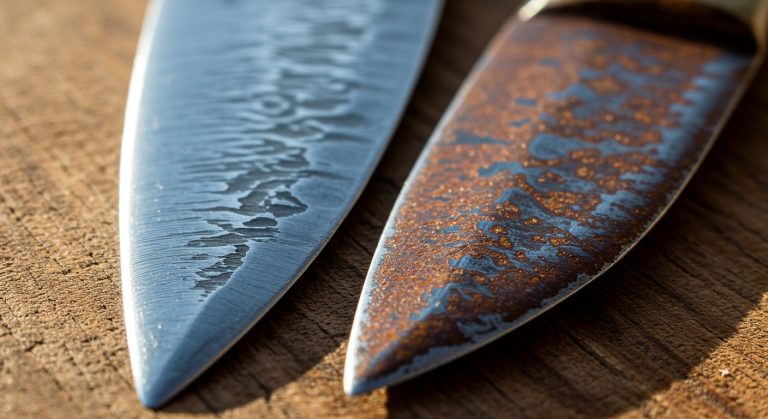Why Is It Unsafe to Use a Dull Knife: Stay Safe in the Kitchen
Using a dull knife is unsafe because it requires more force, leading to slips and a lack of control.
This increases the risk of traumatic injuries, as erratic movements can cause deep cuts and jagged wounds that take longer to heal. Plus, dull knives can result in food waste by crushing rather than slicing.
Keeping your knives sharp not only boosts safety but also improves your cooking efficiency. There’s much more to learn about knife safety and care.
Key Takeaways
- Dull knives require more force to cut, increasing the likelihood of slips and unpredictable movements, which can lead to serious injuries.
- Cuts made by dull knives are jagged, resulting in prolonged healing time and higher chances of infections.
- Increased pressure from using dull knives can cause control issues, making it difficult to maintain cutting accuracy and leading to accidents.
- The misconception that dull knives are safer can contribute to a higher risk of injuries in the kitchen.
- Sharp knives create cleaner cuts, reducing food waste and enhancing efficiency, ultimately promoting a safer cooking experience.
Increased Force Required
When you use a dull knife, you quickly realize that it requires considerably more force to make even simple cuts. This increased effort not only makes your task tedious but also raises the risk of injury.
As you apply more force, the knife can slip or twist unexpectedly, leading to dangerous situations. Sharp knives, in contrast, slice effortlessly, reducing the chance of accidents.
Furthermore, the strain of using a dull knife can cause muscle fatigue, wrist pain, and long-term discomfort. You might find yourself expending unnecessary energy, ultimately slowing down your food preparation.
Using a dull knife also increases the risk of cuts and injuries from excessive force. Regularly sharpening your knives guarantees safety and efficiency, keeping your culinary tasks smooth and enjoyable. Sharp knives enhance safety in the kitchen by minimizing the likelihood of slips and accidents.
Lack of Control
Using a dull knife can severely compromise your control while cutting, making tasks not only frustrating but also hazardous.
Using a dull knife undermines control and safety, turning cutting tasks into frustrating and risky endeavors.
When you’re struggling with a dull blade, you might find yourself facing several risks:
- Slippage Risk: Increased force leads to a higher chance of slipping.
- Unpredictable Movement: The knife’s erratic movements make it hard to stay on track.
- Poor Grip: Dull knives don’t grip materials well, causing them to slide.
- Bad Cutting Technique: You may develop unsafe habits that linger even when using a sharp knife. Additionally, using a dull knife can lead to increased bacterial growth on the surface due to the harder-to-clean nature of the blade.
These factors can create a chaotic cutting environment, increasing the likelihood of accidents. Additionally, using a dull knife requires more increased force, which can further diminish your control over the cutting process.
Traumatic Injuries
While it might seem trivial, a dull knife greatly raises the risk of traumatic injuries in the kitchen.
You’re forced to apply more pressure to cut, increasing the chance of slips and unpredictable movements. These mishaps often result in severe injuries, like deep tears rather than clean cuts, especially to your fingers and thumbs.
Understanding analytics can help you recognize the importance of maintaining sharp knives to ensure safety while cooking. Using a dull knife can lead to chipping and gouging that further complicates cutting tasks and heightens injury risk.
The tearing nature of dull knives can lead to serious wounds that might require emergency treatment. In fact, between 1990 and 2008, around 8.2 million knife-related injuries in the U.S. needed medical attention.
By keeping your knives sharp, you’ll not only enhance your cooking efficiency but also greatly reduce the risk and severity of traumatic injuries.
Safety in Workplaces
A dull knife doesn’t just pose a risk in home kitchens; it can lead to serious safety concerns in workplaces too.
In fact, knife-related accidents account for a significant number of workplace injuries.
- 43,000 knife-based accidents were reported in 2019, highlighting the risk.
- Hand knife injuries contribute to 25-50% of lost time in the plastics industry.
- Safety knives and cut-resistant gear can substantially reduce these risks.
- Proper training and strict adherence to safety protocols are essential.
Impact on Technique
When you work with a dull knife, you’ll find that the increased force required to cut through ingredients not only leads to fatigue but also compromises your control over the blade. This struggle can result in unpredictable cutting motions, making it harder to achieve precise cuts.
Dull knives often tear or crush food, affecting the presentation and texture of your dishes. You might notice that your prep time increases, slowing down your cooking process and causing frustration. Slipping becomes common, especially with slippery ingredients, raising the risk of accidents.
Ultimately, relying on a dull knife can hinder your culinary skills, discouraging you from mastering techniques and experimenting with new recipes. Additionally, using a dull knife can lead to a lack of self-evaluation and feedback, as you may not be able to accurately assess your cutting techniques.
The lack of a sharp edge diminishes knife performance, which is crucial for efficient and safe food preparation.
Maintenance and Prevention
To keep your knives safe and efficient, proper maintenance and prevention are essential.
Regular attention to your knives not only prolongs their life but also guarantees peak performance. Here are some key practices to follow:
- Clean: Hand wash with gentle soap and lukewarm water.
- Dry: Always dry immediately with a soft cloth to prevent rust. Proper cleaning is crucial to avoid light hueing on stainless steel, as corrosion resistance is vital for stainless steel knives.
- Store: Use a knife block or magnetic holder to protect the blade.
- Sharpen: Regularly sharpen and hone your knives to maintain their edge.
Risks in High-Speed Environments
In fast-paced environments, using a dull knife greatly raises the risk of accidents. You’ll find that the extra pressure to cut can lead to a loss of control, making precision nearly impossible.
This combination not only compromises safety but also hinders your efficiency, affecting overall performance.
In fact, sharp knives are inherently safer compared to their dull counterparts, emphasizing the importance of maintaining cutting tools in optimal condition.
Increased Accident Potential
Using a dull knife in a high-speed environment can considerably increase your risk of accidents. The need for more force when cutting leads to a greater chance of slipping and losing control.
In busy kitchens or fast-paced settings, the unpredictability of a dull knife can be dangerous. Consider these hazards:
- Slipping risk: Increased force raises the likelihood of the knife slipping.
- Control issues: Excessive pressure diminishes your control over the cutting task.
- Unpredictable behavior: Dull knives tear rather than slice, causing erratic movements. Regular sharpening(to maintain the knife’s edge) is crucial to minimize these risks.
- Injury severity: Cuts from dull knives are often jagged and take longer to heal. Sharp knives require less force, making them a safer choice in high-speed environments.
Efficiency and Precision Loss
While a dull knife might seem harmless, it greatly hampers your efficiency and precision in high-speed environments. Dull knives slow you down, requiring more time and effort to cut, which can lead to fatigue and frustration.
In the kitchen, this inefficiency can prolong cooking times and lower meal quality, as food gets crushed instead of sliced cleanly. You risk uneven cuts and loss of control, making delicate ingredients like herbs or fish difficult to manage.
This not only increases food waste but can also negatively impact the presentation of dishes. Additionally, dull knives require more force to cut effectively, increasing the risk of slips and accidents.
The need for more force is particularly dangerous when handling single bevel knives, which are designed for precision and require a delicate touch.
In fast-paced settings, these challenges can reduce reaction time and affect team performance, leading to safety concerns.
Poor Cutting Habits
When you use a dull knife, you have to apply more force to get through your ingredients, which can lead to unpredictable blade movement.
This increase in pressure not only makes cutting harder but also raises the chance of slips and accidents. Additionally, dull knives require excessive force, which further increases the risk of injury while preparing food.
Increased Cutting Force
A dull knife demands more force to cut through food efficiently, which can lead to increased risk of accidents in the kitchen.
When you’re exerting extra pressure, you’re not just cutting; you’re inviting danger.
- You might lose control of the blade.
- Increased force can cause the knife to slip unexpectedly.
- Poor cutting techniques develop, leading to erratic movements.
- The risk of injury heightens as the knife is more likely to cause cuts. Additionally, dull knives require more force, making it easier to sustain injuries.
Unpredictable Blade Movement
Using a dull knife not only makes cutting more difficult but also leads to unpredictable blade movement, heightening the risk of accidents.
When you use a dull blade, it often slips off food surfaces, resulting in uncontrolled movements that can cause injuries. The lack of clean cuts means you lose control, and a stuck knife can suddenly break through, catching you off guard.
Additionally, a sharp knife reduces the likelihood of accidents as it allows for better control during cutting. A razor-sharp boning knife provides the precision needed to navigate around bones effectively.
Additionally, the sawing motion required with dull knives is less stable, amplifying the danger. As you apply more pressure, you risk crushing food instead of cutting it.
The Importance of Regular Sharpening
Regularly sharpening your knives is essential for maintaining safety and efficiency in the kitchen. A sharp knife not only enhances your control but also makes food prep quicker and more enjoyable.
Failing to sharpen leads to increased risks and frustrations.
- Increased Safety Risks: Dull knives require more force, raising the chance of accidents.
- Reduced Efficiency: Tasks become more time-consuming and prone to errors. Sharp knives allow for quick and effortless cutting of ingredients, making meal prep more efficient.
- Shortened Knife Lifespan: Neglecting sharpening causes premature wear and damage.
- Poor Food Preparation: Dull blades crush ingredients, affecting flavor and presentation.
Educating Users on Knife Safety
Educating yourself about knife safety is essential for preventing accidents in the kitchen. By understanding the importance of regular sharpening, recognizing the risks of dull knives, and mastering the best cutting techniques, you can greatly reduce the chance of injury.
It is important to note that knife incident occurs every 25 minutes, underscoring the need for careful handling and awareness.
Regularly checking for a burr along the cutting edge can help maintain your knife’s sharpness and safety.
Recognizing Dull Knife Risks
How can something as simple as a dull knife pose serious risks in your kitchen?
Using a dull knife requires more force, increasing the chance of slippage and accidents. This extra pressure can lead to loss of control, resulting in injuries. Cuts from dull knives are often more traumatic, causing jagged wounds that take longer to heal and may lead to infections.
Furthermore, dull knives fail to cut cleanly, which can result in additional frustration and increased risk of accidents in the kitchen.
Additionally, dull knives lack precision, leading to crushed food and waste. You might think dull knives are safer, but that misconception can put you at greater risk.
Best Cutting Techniques
Using the right cutting techniques not only enhances your culinary skills but also greatly boosts your safety in the kitchen.
Employing proper techniques reduces the risk of accidents and guarantees more efficient food preparation. Here are some key points to remember:
- Proper Grip: Master the pinch or handle grip for better control.
- Cutting Direction: Always cut away from your body to avoid injuries.
- Stable Surface: Use a non-slip cutting board to keep ingredients secure.
- Claw Grip: Protect your fingers by curling them while cutting. Additionally, using sharp knives is essential, as they require less force and significantly reduce the likelihood of slipping.
Frequently Asked Questions
How Often Should I Sharpen My Kitchen Knives?
Think of your kitchen knife as a trusty steed; it needs regular care to perform its best.
For home cooks, sharpening once a month keeps it ready for action. If you’re a professional chef, aim for weekly sharpening to handle daily demands.
For those who use knives less frequently, two to three times a year might suffice.
What Tools Are Best for Sharpening Knives?
When it comes to sharpening your knives, consider the Work Sharp Ken Onion Edition for versatility, or the Chef’sChoice 1520 for a user-friendly electric option.
If you prefer manual sharpening, the ZWILLING pull-through sharpener is easy to use.
For budget-friendly choices, try the Sharp Pebble whetstone.
Professionals should look at the Wicked Edge Generation 4 Pro for precision.
Choosing the right tool can greatly enhance your knife’s performance and longevity.
Can a Dull Knife Be Dangerous for Children?
Can a dull knife really be dangerous for children? Absolutely!
When kids use dull knives, they struggle to cut through food, requiring more force and control. This increases the risk of slipping and accidents, leading to potential injuries.
Since children lack strength and experience, they’re more likely to get hurt. Teaching safe knife skills with sharp, well-maintained tools can help prevent accidents and build their confidence in the kitchen.
Keep safety a priority!
Are There Specific Signs That Indicate a Knife Is Dull?
You can spot a dull knife by noticing a few key signs.
If you find yourself applying more pressure when cutting, that’s a red flag.
Watch for slipping; if the knife isn’t cutting straight, it’s likely dull.
Look for visible damage on the blade, like chips or bends.
Additionally, if your ingredients are fraying or bruising, it’s time to sharpen up.
A sharp knife will make your kitchen tasks smoother and more efficient.
What Are the Best Practices for Storing Sharp Knives Safely?
Did you know that 70% of knife-related injuries happen due to improper storage?
To store sharp knives safely, consider using magnetic strips, knife blocks, or drawer blocks to keep them organized and protected. Always make sure they’re out of children’s reach to prevent accidents.
Using blade guards can also shield edges from damage.
Regularly clean your storage solutions to maintain a safe, hygienic environment for your knives, making certain they stay sharp and ready for use.
A Sharp Knife Is a Safe Knife: Finish Your Cooking with Precision
Using a dull knife is like trying to slice bread with a rubber band utterly disastrous. You’ll end up wrestling with your food, risking serious injury, and creating a kitchen battlefield instead of a culinary masterpiece.
Don’t let a blunt blade turn you into a chopping hazard; sharpen those knives regularly. Embrace the joy of effortless cutting and keep your fingers safe.
Your kitchen deserves the best, and so do you! Take knife safety seriously it’s a cut above the rest.

